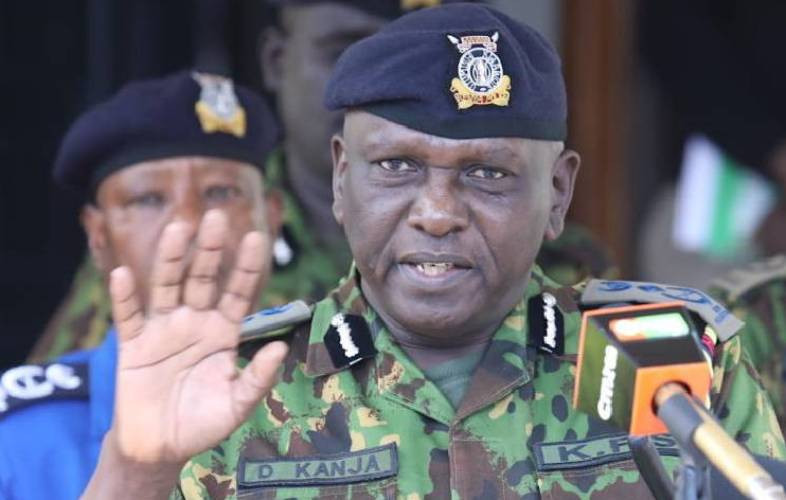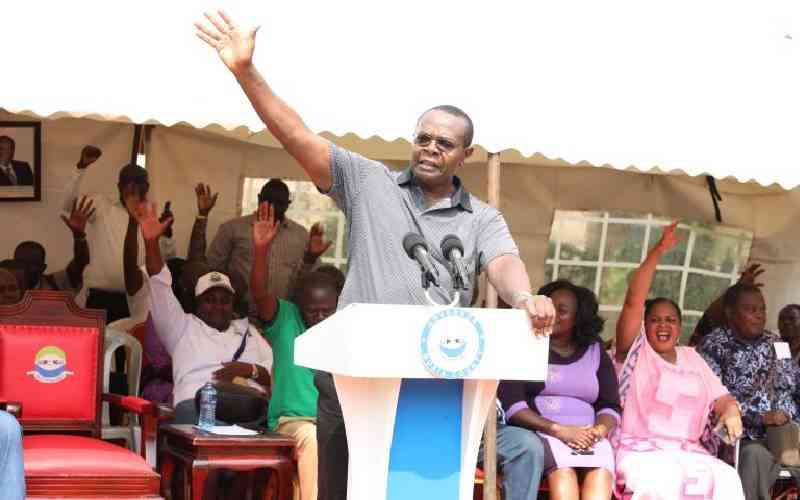By Dann Okoth
Do you know who was Kenya’s first indigenous doctor, the first accountant, the first lawyer? And do you remember when Patrick Njiru competed in the first Safari Rally and when Kipchoge Keino won Kenya an Olympic gold medal?
These Kenyan events of national pride are now recorded in a book on Kenyan records.
Some happened long ago while others in living memory, but are now registered as Kenyan records.
 |
Kenya Book of Records depicts landmarks in history. Inset: Oldest pupil Kimani Maruge. [PHOTO: TABITHA OTWORI/STANDARD] |
The first Kenyan book of records has been launched along the lines of the renowned ‘World Guinness Book of Records’.
The publisher of the first-time chronicle, ‘Kenya Book of Records’, Mr Kondia Mwaniki Wachira, has delved to far back as the 1920s to bring out people, things and events that shaped Kenya.
It is interesting flipping through pages of the country’s milestones.
The first Kenyan Accountant, who qualified in Scotland in1959, was John Mwangi of then Pannel Bellhouse Mwangi firm; the first doctor was Dr Jason Clement Likimani, who obtained a diploma in medicine from then University of East Africa which later upgraded the qualification to a degree.
The first woman doctor was Florence Ng’endo, who qualified in the US in 1965; Charles Michael George Argwings Kodhek obtained a law degree from London in 1949, becoming Kenya’s first indigenous lawyer. The first architect was David Mutiso, who qualified in the UK in 1956 and took part in designing Kenyatta International Conference Centre, Nairobi.
The 210 page glossy package contains historical records from 1920 to December 2007.
"We were challenged by Debra Mallowah, the then Tusker marketing manager, our sponsors, to come up with relevant questions," says Wachira, the publisher.
"This proved to be harder than we had thought because we found out that most information about Kenyans and their country was yet to be documented," he adds.
From landscapes and cultural diversity to the country’s heroes and heroines, the book touches all aspects of society in perhaps, a way it has not been done before.
Glory and glamour
Stay informed. Subscribe to our newsletter
From Munyao Kisoi, the man who raised the Kenyan flag on the peak of Mount Kenya after independence, Kimani Maruge, the world’s oldest pupil to Wangari Maathai, the first African woman to win a Nobel Peace Prize, the book captures Kenya in glamour and glory.
Did you know, for example, how the country acquired its name?
The book says the land and space known as Kenya got the name in 1920 when it became a colony as part of British East Africa Protectorate.
In 1849, CMS pioneer missionary Johan Ludwig Krapf, during one of his travels out of his base in Rabai mission, sighted a lofty snow capped mountain.
He named it mount Kenya, a corruption of "kiima kia Kiinyaa" (Mt Kirinyaga). It is the Kamba version of Kirima gia Kirinyaga, which is what the Agikuyu, who live near the mountain, call it. The phrase translates into the ‘mountain of Kirinyaga’.
But what does Kirinyaga mean? The Kikuyu ‘kiri’ means with or possessing. The word ‘nyaga’ means the ostrich.
However, ‘nyaga’ as used in Kirinyaga, refers to patches, which is how the mountain appears from far.
The Kikuyu god "Mwenye Nyaga" can be translated as owner of the mountain with snow patches. Kenya, therefore, means ‘with patches’.
But it is how the book delves into history, achievements and uniqueness of Kenya and its people that is more captivating.
The chronology of events that led to the birth of the nation begins with Vasco Da Gama and follows through to the arrival of the missionaries, colonisation, building of the Kenya-Uganda Railway, Independence Day and present day politics.
Freedom Struggle
The book celebrates how Kenyans fought for independence and singles out Harry Thuku, Dedan Kimathi, Jomo Kenyatta, Oginga Odinga and Paul Ngei, among others.
It delves into politics and political parties, tracing them from independence to the 2007 General Election. The text highlights interesting political detail hitherto ignored.
For instance, did you know that William Samoei Ruto set a new record when he polled 78,472 votes in Eldoret North Constituency in the last General Election, eclipsing the old record of 46,782 votes set by David Mwenje in Embakasi in the 2002 election?
And Dickson Kihika Kimani set the record as the only Kenyan, who contested and won elections in three different constituencies of Nakuru North, Laikipia West and Molo.
Former President Moi holds the record as the longest serving elected MP, having held the Baringo Central seat between March 1957 and December 2002, a record of 45 years after serving as nominated MP in 1955 at the Legislative Council for two years.
But the publisher says: "Although we have tried to corroborate all facts and cross check as much as possible, we do not rule out a small per cent of factual or contextual errors."
 The Standard Group Plc is a
multi-media organization with investments in media platforms spanning newspaper
print operations, television, radio broadcasting, digital and online services. The
Standard Group is recognized as a leading multi-media house in Kenya with a key
influence in matters of national and international interest.
The Standard Group Plc is a
multi-media organization with investments in media platforms spanning newspaper
print operations, television, radio broadcasting, digital and online services. The
Standard Group is recognized as a leading multi-media house in Kenya with a key
influence in matters of national and international interest.
 The Standard Group Plc is a
multi-media organization with investments in media platforms spanning newspaper
print operations, television, radio broadcasting, digital and online services. The
Standard Group is recognized as a leading multi-media house in Kenya with a key
influence in matters of national and international interest.
The Standard Group Plc is a
multi-media organization with investments in media platforms spanning newspaper
print operations, television, radio broadcasting, digital and online services. The
Standard Group is recognized as a leading multi-media house in Kenya with a key
influence in matters of national and international interest.






